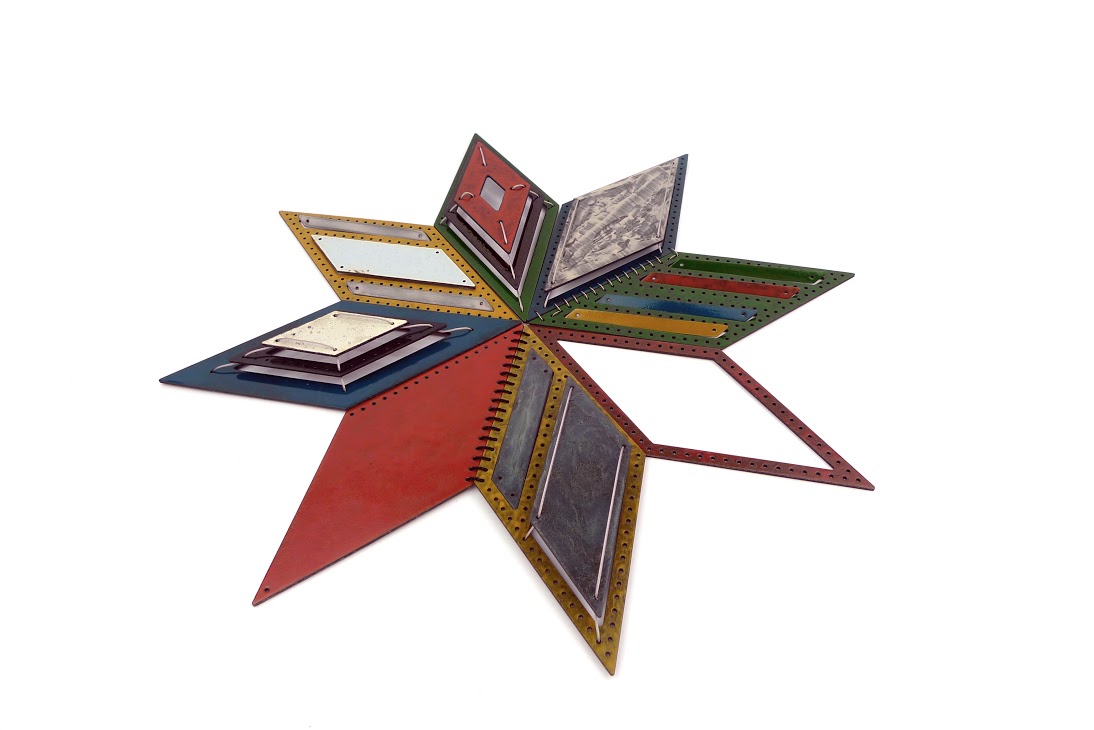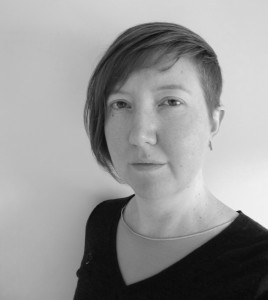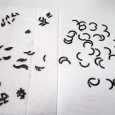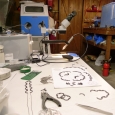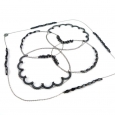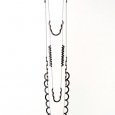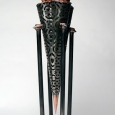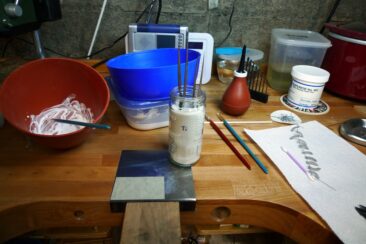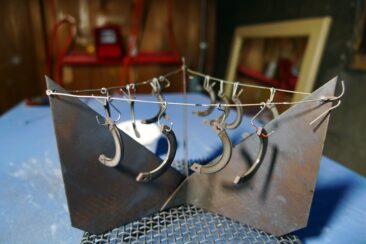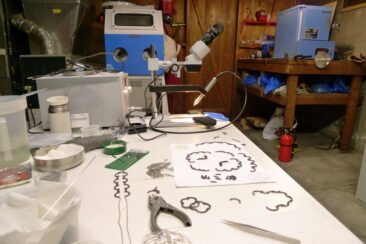Melissa is an Australian-born artist jeweller who lives and works in Seattle, Washington in the USA. She holds a Masters of Fine Art in jewellery and metalsmithing from Monash University and Bachelor of Art with honours in interior architecture from Curtin University. Her works are in the collections of the National Gallery of Australia (Canberra), the Cheongju City Collection (South Korea) and the Arts Centre Melbourne (Australia), and her pieces have featured in the publications Jewel Book, Art Jewellery Today 3 and Lark Books’ 500 Silver Jewelry Designs.
What is your background and training?
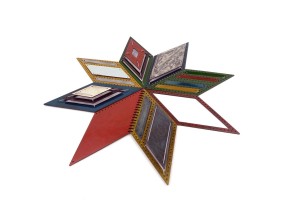
I was born and raised in Perth, in Western Australia. At twelve years old, I decided that I wanted to be an architect. This was not far off the field of engineering that my mother had once remarked would be my future career – a comment that was apparently made as she was overseeing me build the straightest and highest building-block towers she’d ever seen raised by a two-year-old. But then at thirteen I started a jewelry course at school, and made a twist bangle that was so well finished that when my grandfather saw it he assumed I had bought it, and so immediately launched into explaining the making process to me. Eventually architecture won out and I earned my undergraduate degree in interior architecture at Curtin University before commencing work as interior designer.
I specialized in commercial interiors, offices and store fit-outs for five years, before heading back to full-time studies at university, this time in jewelry and metalsmithing. A one-year Post Graduate Diploma preceded me taking up a position at a university across the country, which saw my new husband and I decamp to Melbourne in 2007, where I completed my MFA at Monash University in 2009.
I set up my first studio in the low-rent section of St Kilda, a beachside neighborhood a few miles from downtown Melbourne, and got down to the business of being a jewelry artist. After five years in Melbourne it was my husband Bruce’s career that prompted us to move, when he was recruited from Australia to a position in Seattle. Since the move, in 2012, I have been working from the studio that I set up in the basement of our rented house in Queen Anne.
What are you working on in your studio now?
I have just finished three enameled neckpieces for a show that invited collaboration between metal artists with different backgrounds. I worked with a sculptor, Sean Macmillan, who is head of jewelry and metals at Slippery Rock University, on a set of works entitled Quatrefoil Quartet. The four pieces are one sculpture and three neckpieces, made in enameled steel and copper. The output from each of us is as you would expect – sculpture and jewelry, except that I designed a lacy pattern that was laser cut into the metal from which Sean made his sculptural work. And the fall-out parts of the pattern came back to me and formed the main ingredients of my neckpieces – essentially I was making jewelry out of Sean’s scrap. Confused? I think the images explain it best
Tell us about your process and how you came to work this way and has your practice changed much over time?
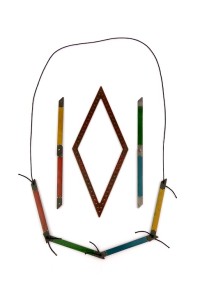
Well, my time as an interior designer has had a huge influence over my jeweler career. I’d like to say that if I went straight into jewelry I would be working on the same sort of things, but I’m not sure I would have had the patience to learn AutoCad without the need to use it as my only way of communicating, day in and day out. The way that drawings are made, and the process of testing ideas through drawing is something that was drilled into me at architecture school, and I’m very glad of that training as it influences everything that I do.
In my works I combine the disciplines of architecture and jewelery making to create spatially dynamic objects for wear and display. Through the manipulation of the materials of jewelry, and by dismantling familiar objects related to the body and the home, I aim to interrogate not just the intimate space of the body, but also architectural space, where the body is located.
Like my careers, I also have two streams of practice, one; working with reusing existing objects, and the other working with the un-bordered plane, the second of which is facilitated by laser cutting. Working with objects gives me pattern references and constraints from the very outset (similar to designing for a building), which I see as a sort of collaboration between my sensibilities and what exists already in the object. These works are heavily researched and respond to themes of social conscience. Working with the plane is the opposite; I feel as though it’s my job to encourage these patterns that I start from a little kernel of an idea to sprawl across the metal uninhibited, until they’re exhausted. Utilizing laser cutting technology allows me to work with infinite repetitions as the continuous pattern arrangements are able to spread far beyond what I would be capable of cutting by hand with my jewelers saw.
Each side of my making – the flat works and object related works – feeds into the other, with my creative development fuelled by the constraints that arise when dealing with tightly confined or alternately completely undefined planes. And like I said, both sides are influenced by my design career, as I use AutoCad for drawing every work, the laser-cut and the hand-sawn pieces.
The main change so far has been in what I choose to represent in my works. Early in my career it was enough for me to just get a handle on patterns that I wanted and to present them in a mathematically rigorous form, alongside needing to perfect technique. Now I have a reasonable handle on these things the way of introducing more complexity into the work, and more soul for that matter, falls to the things I notice in the world around me, which is often the society in which we live. These become my pattern motifs, which remain the drivers of my
works.
Do you experiment a lot or do you work within a specific set of parameters?
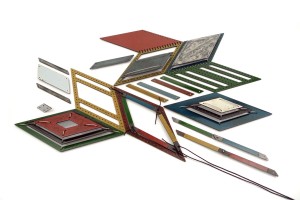
This may seem slightly nonsensical, but I like to experiment within set parameters. I set up quite rigid plans in AutoCad before I make anything, but I leave a lot of parts of those plans unresolved so that when I get to the bench I have room for play. A good example is my laser cut work. I have lots of pieces cut that I then arrange on my bench, from which I get to build anything that I can. It’s like I’ve built my own personal set of Lego and I can use anything to solder or weld or glue or stitch the pieces together. The works that I come up with from these pieces are pure experiment, but they are experiments with a bunch of tools that I made. The only conditions are that they have to be self-supporting and wearable, and sometimes the wearable is optional too!
Describe your teaching style.
Australian! We’re fairly anti-authoritarian, so in that vein I like to set people out as independent researchers. This means that people don’t have to follow too many specific guidelines, but rather follow their own interests, and has the added advantage that with everyone discovering different things everyone gets to learn from everybody else.
What most inspires you?
Architecture. Systems. Straight lines. Logic. Puzzles. Pattern. Cities.
Who are your favorite enamelists? (what are your most important influences)
I would not be enameling if not for a workshop and residency I did with Elizabeth Turrell, and through her meeting another influence and now friend, Beate Gegenwart. Favourites: Bettina Dittlmann (for her flat pendants – I saw them in Flow gallery in London and was immediately hooked), Inari Kiuru, Moritz Götze, Kaori Juzu
What is your dream project?
To go to the Czech Republic to study the Tugendhat House by architect Ludwig Mies van der Rohe and make work in response to this experience.
Tell us about the workshop you will be offering at the EGNE conference.
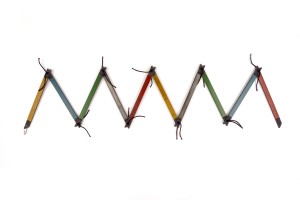
I like the utility of using steel as a base material, and ideally I’d like to infect a few more enamellers with steel fever, so my aim is to showcase the abilities and diversity of these materials. Which means starting out with solid foundations (since steel can be fussy), so getting everyone adept at the gold standard of how to apply liquid enamel onto steel, and then by introducing some tips and tricks that can help to make the less than ideal circumstances work.
In my own practice I often work with single colors, trying to build texture and interest through introducing faults or repeatable influences that don’t necessarily involve traditional painting or color layering as techniques. I like to design ways of altering the enamel, using techniques that exploit the benefits of wet process enamel, so I will be encouraging everyone to discover their own techniques of disrupting the surface, using ways that I might never have been able to think up.
Is there anything you’d like to add?
I’d like to thank you for being brave enough to invite an Australian artist to come to Upstate New York during the winter months. Having been raised without seeing it until I was sixteen, I can never get enough snow!
To see more of her work please visit http://www.melissacameron.net/

